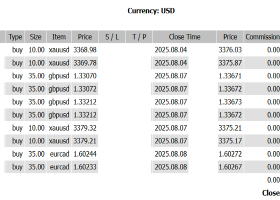
💵 +73,293 USD – How the Market Moves After the FOMC! Weekly Outlook for August 11, 2025|Key Drivers & Market Recap
💵 +73,293 USD – How the Market Moves After the FOMC!
Weekly Outlook for August 11, 2025|Key Drivers & Market Recap
✅ Trade Summary (August 4 – August 8)
📊 Weekly P/L: +73,293 USD
🌐 Market Highlights This Week (Aug 4 – Aug 8)
-
USD/JPY: Dropped sharply after the downward revision of July’s U.S. jobs report. Briefly rebounded on real demand buying from Japan, but softened again following reports related to the Fed Chair nomination.
-
EUR/USD: Fell to 1.1528, then recovered to 1.1669 on expectations of an FOMC rate cut.
-
GBP/JPY: Surged back to the 198 level after the BOE’s rate cut announcement.
-
CAD/JPY: Traded quietly around 107 yen, capped by U.S.-Canada trade talks and rate cut speculation.
-
AUD/JPY: Dropped to the 94 level after U.S. jobs data, then recovered to the 96 level.
-
ZAR/JPY: Started the week weak, then rebounded from 8.09 to above 8.30.
💱 Key Focus by Currency (Aug 11 Week)
-
USD/JPY: U.S. CPI (14th) and retail sales (15th) in focus. In Japan, GDP flash estimate and political developments to be watched.
-
EUR/USD: Weighed by eurozone economic concerns. Key data include Germany’s ZEW sentiment (13th) and industrial production (14th).
-
GBP/JPY: Following the BOE’s rate cut, direction may shift based on UK GDP and jobs data.
-
CAD/JPY: Watch U.S.-Canada negotiations, Aug 13 trade balance, and Aug 15 employment data.
-
AUD/JPY: RBA meeting (11–12th) likely to confirm a rate cut. Chinese economic indicators also in focus.
-
ZAR/JPY: Aug 13 unemployment rate, Aug 14 retail sales, and ongoing U.S. tariff concerns remain key.
📝 Afterword|In Markets and Sodium Levels, Balance Is Everything
Thank you for reading this week’s report.
Recently, I came across an article about the link between stress and low sodium levels.
In short, sodium is essential for maintaining blood pressure, fluid balance, and proper muscle and nerve function. But stress can affect this balance in different ways depending on the person.
Short-term stress may cause the body to excrete more sodium through urine, while some people retain it. Chronic stress, illness, excessive fluid intake, and certain medications can also lead to hyponatremia (below 135 mEq/L). Symptoms range from mild fatigue and headaches to seizures or loss of consciousness, with treatment depending on the cause and duration.
Reading this, I saw a clear parallel to the markets.
When the market faces stress—whether from news or geopolitical risks—liquidity can suddenly drain or flood in excessively. The extent and recovery time depend on market conditions and participants’ reactions.
In the end, identifying the cause and tailoring the response is key.
Just as you manage fluid and salt balance for your health, in trading it’s vital to keep position sizing and risk management in balance.
Next week, let’s be prepared for both “market dehydration” and “excess liquidity,” so we can handle sudden changes.
Wishing you a great weekend.


